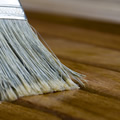Should I use the Marine products in a bathroom?
We are asked quite often if our Waterlox MARINE finishing system is recommended for surfaces near water – like a bathroom or kitchen. The simple answer is “no.”Our interior sealers and finishes will provide the water resistance needed for these type of applications. It is true that Waterlox MARINE products are water resistant; however, they … Should I use the Marine products in a bathroom?







